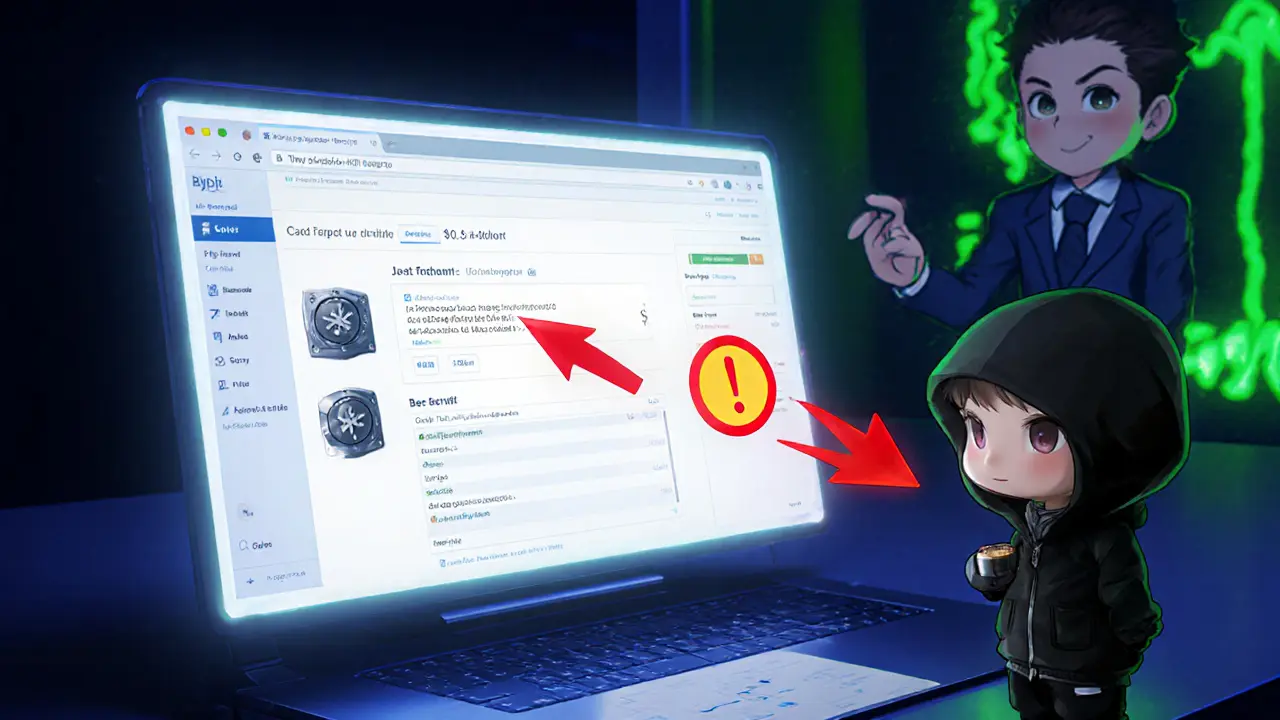Lazarus Group Crypto Theft Impact Calculator
Total Amount Stolen:
$1,500,000,000
Attack Vector Used:
UI Manipulation
Estimated Recovery Potential:
$40,000,000
Ecosystem Impact Score:
High
UI Manipulation
Alters transaction payloads just before signing, often used in major exchanges like Bybit.
Cold-to-Hot Wallet Abuse
Exploits the vulnerable transition period between offline and online wallets.
Supply Chain Infiltration
Deploys trojans through legitimate software updates to gain access.
Spear-Phishing
Tricks employees into providing credentials via deceptive messages.
Malicious Update
Injects harmful code into trading apps during legitimate updates.
Credential Stuffing
Uses stolen credentials across multiple platforms to gain access.
When it comes to crypto crime, the name Lazarus Group is synonymous with scale, sophistication, and state‑backed motives. A North Korean cyber‑espionage unit operating under the Reconnaissance General Bureau, Lazarus has turned cryptocurrency theft into a strategic funding stream for the regime’s nuclear program.
Why Lazarus Targets the Crypto Ecosystem
Traditional sanctions choke North Korea’s access to the global banking system, but digital assets move across borders without needing a correspondent bank. By stealing Bitcoin, Ethereum, and stablecoins, Lazarus creates a liquid, pseudonymous revenue source that can be quickly converted into cash, weapons, or technology.
Key Attack Vectors in Recent Heists
Since mid‑2024, the group has refined a playbook that blends social engineering, supply‑chain infiltration, and clever manipulation of transaction workflows. The most common steps are:
- Spear‑phishing or recruiter‑style outreach - attackers pose as recruiters, investors, or partners on platforms like LinkedIn to win trust.
- Compromise of privileged accounts - once a staff member clicks a malicious link, attackers harvest credentials for the exchange’s admin console.
- Front‑end transaction tampering - by injecting code into wallet UI (as seen in the Bybit breach), they alter transaction data right before the user signs it.
- Cold‑to‑hot wallet switchover abuse - during routine fund transfers, they reroute assets to attacker‑controlled hot wallets before the cold‑wallet signature is finalized.
- Cross‑chain mixing and laundering - stolen coins are funneled through decentralized exchanges, mixers, and previously used laundering addresses to obscure origins.
Case Study: The Bybit $1.5B Heist (Feb212025)
Bybit, a major crypto exchange, fell victim to a four‑phase assault that set new records for both value and technical finesse.
- Phase1 - Phishing: Targeted emails reached senior staff, granting attackers read‑only access to the exchange’s internal dashboard.
- Phase2 - Transaction fabrication: Fake transfer requests were generated, moving assets from a secure Ethereum cold wallet to a temporary hot wallet.
- Phase3 - UI manipulation: While CEO Ben Zhou approved a routine transfer, malicious JavaScript altered the payload, redirecting roughly 401,000 ETH (≈$1.46B) to an attacker‑controlled address.
- Phase4 - Laundering: The ETH was partially swapped for Bitcoin and Dai on decentralized platforms, then split across a network of wallets designed to evade blockchain analytics.
Elliptic’s analysis showed the loot later converged with funds from earlier Stake.com and Atomic Wallet thefts, a tactic known as “cross‑contamination” that further muddies the audit trail.

Other Major Lazarus Operations (2025)
| Target | Date | Amount Stolen | Primary Vector |
|---|---|---|---|
| Bybit | Feb212025 | $1.5B | UI manipulation + cold‑hot wallet abuse |
| Atomic Wallet | Mar142025 | $100M | Spear‑phishing of admin accounts |
| CoinsPaid | Jun32025 | $37.3M | Malicious update in trading app |
| Alphapo | Aug192025 | $60M | Supply‑chain trojan (MANUSCRYPT) |
| Stake.com | Sep72025 | $41M | Credential stuffing + hot‑wallet hijack |
Technical Arsenal Behind the Attacks
The group’s toolbox reads like a malware catalogue:
- MANUSCRYPT RAT - an AES‑256 encrypted remote access trojan used to harvest wallet keys after initial compromise.
- TraderTraitor framework - embeds hidden update mechanisms in seemingly legitimate crypto‑trading applications, linking compromised clients to command‑and‑control servers.
- AppleJeus - a trojanized macOS binary that slips past app‑store reviews and injects code into exchange software.
- Multi‑signature transaction spoofing - alters the data sent to hardware wallets, effectively bypassing the “multiple signers” safeguard.
What ties these tools together is a focus on the cold wallet → hot wallet transition, the exact moment assets leave offline protection and become vulnerable.
Defensive Lessons for Exchanges and Wallet Providers
Industry experts agree that human error remains the weakest link, even in environments fortified with hardware security modules. Practical steps to raise the bar include:
- Mandate hardware‑backed multi‑factor authentication for any admin console activity.
- Separate duties: require two independent teams to approve a cold‑to‑hot transfer, each using distinct devices.
- Implement transaction‑level UI integrity checks that cryptographically verify the payload before it reaches the signer.
- Deploy continuous behavioral analytics that flag anomalous transaction patterns, such as large transfers following a recent login from an unfamiliar IP.
- Conduct regular social‑engineering simulations to keep staff alert to recruiter‑style phishing.
Bybit’s partial recovery of $40M demonstrates that collaborative forensic work with firms like Elliptic can trace and freeze funds, but the sheer speed of these attacks leaves little room for reaction.
Broader Implications for the Crypto Ecosystem
When a state‑sponsored group can breach multi‑signature wallets, the entire premise of “secure cold storage” is called into question. Regulators, exchanges, and infrastructure providers must consider a coordinated response:
- Standardize cold‑wallet audit logs that are immutable and verifiable by third‑party auditors.
- Develop global information‑sharing platforms for real‑time threat intel on illicit laundering addresses.
- Explore geo‑fencing of high‑value withdrawals to restrict movement to known, vetted jurisdictions.
Until such systemic defenses emerge, the cryptocurrency market will continue to be an attractive target for nations seeking revenue outside the traditional banking system.

Frequently Asked Questions
How did Lazarus Group manage to steal $1.5billion from Bybit?
The attackers first gained access to privileged accounts via spear‑phishing, then created fake transfer requests. When a senior executive approved a routine transaction, malicious code hidden in the wallet UI altered the destination address, diverting 401,000ETH to an attacker‑controlled wallet. The loot was later split across multiple addresses and partially converted to Bitcoin and stablecoins.
What is the “cross‑contamination” technique mentioned by analysts?
It’s a laundering strategy where funds from different hacks are mixed together in the same series of wallets. By sending stolen assets from Stake.com, Atomic Wallet, and CoinEx through shared mixer addresses, investigators find it harder to attribute any single theft to a specific source.
Can multi‑signature wallets still protect against state‑level attackers?
They add a layer of defense, but Lazarus has shown it can be bypassed by tampering with the transaction data before signatures are applied. Strong UI integrity checks and independent signing devices are needed to make multi‑sig truly effective.
What role does the Reconnaissance General Bureau play?
The Reconnaissance General Bureau is North Korea’s chief intelligence agency. Lazarus Group operates under its command, turning cyber‑theft into a revenue stream that funds the country’s nuclear weapons and other strategic programs.
How can individual crypto users protect themselves from such attacks?
Avoid clicking links from unexpected messages, use hardware wallets for large holdings, enable 2FA/MFA on every exchange account, and stay skeptical of unsolicited job offers or recruiter messages on professional networks.







Chad Fraser
October 14, 2024 AT 06:05Wow, the depth of Lazarus’ playbook really shows why we need layered defenses. Every exchange should treat admin access like a vault door – multiple people, multiple keys, and a constant audit trail. Adding hardware‑backed MFA on all privileged accounts can cut the phishing success rate dramatically. Also, a sandboxed UI for transaction signing would catch those last‑minute payload swaps. Keep the community sharing intel; the more we know, the faster we can lock down the next vector.
Jayne McCann
October 25, 2024 AT 13:28Honestly, I think the focus on UI manipulation is a bit overblown. Most of the damage comes from the initial credential grab, not the JavaScript tweak. Simpler safeguards like mandatory password changes after any admin login would go a long way.
Richard Herman
November 5, 2024 AT 20:51From a global perspective, these attacks highlight how intertwined our crypto infrastructure has become. Different jurisdictions need to agree on audit log standards so that a cold‑wallet breach in one country can be traced elsewhere. Cultural awareness training can also reduce the effectiveness of recruiter‑style phishing. When teams understand the social engineering angle, they’ll be less likely to click a malicious link. Collaboration across borders is the only real defense against state‑backed groups.
Parker Dixon
November 17, 2024 AT 04:14Reading through the Bybit heist feels like watching a high‑stakes magic trick where the audience never sees the hand‑off. First, they bait a senior exec with a perfectly crafted email – that’s classic social engineering, nothing new, but the timing was immaculate. Then they slip malicious JavaScript into the wallet UI, which subtly changes the destination address right before the signature is applied 😲. The beauty (or horror) of it is that the code runs on the user’s own machine, so traditional network monitors miss it entirely.
Next, the cold‑to‑hot wallet window is exploited; the attackers wait for the routine fund movement and hijack the transaction before the offline signature finalizes. By the time any human eyes the logs, the assets have already been split across mixers and decentralized exchanges.
What’s even more striking is the “cross‑contamination” technique – they mixed stolen funds from previous hacks, creating a tangled web that ruins any forensic trail. This shows that each individual breach isn’t isolated; it’s part of a larger laundering ecosystem.
From a defensive standpoint, multi‑signature wallets are only as strong as the UI that presents the transaction data. If the payload is altered before it reaches the hardware signer, the signatures become meaningless. Implementing cryptographic UI integrity checks could force the signer to verify a hash of the transaction that the UI can’t tamper with.
Also, the human factor remains the weakest link. Regular phishing simulations and a culture where any unexpected request is double‑checked can shave off a huge attack surface. Finally, sharing real‑time threat intel across exchanges would let anyone spot a new vector the moment it appears. The industry needs to move from reactive patches to proactive, collaborative defense. 🌐
celester Johnson
November 28, 2024 AT 11:37One might ponder whether the relentless pursuit of digital wealth by a clandestine state apparatus not only reflects the futility of traditional sanctions but also underscores a deeper philosophical paradox: a regime that denies its citizens freedom yet seeks liberation through theft of a decentralized medium. The Lazarus Group, in its meticulous choreography, mirrors a surgeon’s precision, extracting value from the very veins of a system designed to be trustless. Yet this very trustlessness is eroded each time a malicious update slips through, turning the promise of autonomy into a mirage.
Does the specter of a sovereign power wielding cryptographic might compel us to re‑examine the ethical underpinnings of anonymity? If anonymity can be weaponized, what then becomes of the moral high ground that early crypto advocates claimed? The answer may lie not in technical fortifications alone but in a collective willingness to confront the reality that power, whether state‑bound or not, will always seek avenues to subvert emerging systems.
Prince Chaudhary
December 9, 2024 AT 19:00The takeaway for any platform is simple: empower every team member with the tools to spot suspicious activity, but don’t overload them with noise. Regularly rotate admin credentials and enforce hardware‑based MFA; the extra step may feel cumbersome, yet it’s a proven barrier against credential‑theft. Encourage a culture where reporting a weird email is praised, not mocked. By building trust internally, you reduce the lure of external recruiters posing as opportunities.
John Kinh
December 21, 2024 AT 02:23Another overblown blunder from the crypto world.
Jan B.
January 1, 2025 AT 09:46Multi‑sig must involve separate devices. No single point of failure.
Stefano Benny
January 12, 2025 AT 17:09While the community applauds the need for UI integrity, let’s not forget that the real bottleneck is latency in transaction finality – if you push too hard on checks, you may inadvertently increase confirmation times, causing users to seek cheaper, faster alternatives. 🤔
Bobby Ferew
January 24, 2025 AT 00:33The philosophical musings are nice, but the cold‑wallet transition remains a glaring vulnerability. If the hardware signer isn’t isolated from any software that can be compromised, the attack surface shrinks dramatically.
Mark Camden
February 4, 2025 AT 07:56It is imperative to recognize that the current security paradigm, predicated on perimeter defenses, is fundamentally inadequate against an adversary possessing sovereign resources. A rigorous, defense‑in‑depth strategy, encompassing cryptographic verification of UI payloads, zero‑trust administrative access, and immutable audit trails, is not merely advisable but obligatory.
Evie View
February 15, 2025 AT 15:19Your simple warning about phishing is insufficient; the attackers have refined their social engineering to blend seamlessly with legitimate recruiter outreach. Anyone overlooking that nuance is willfully ignorant.
Sidharth Praveen
February 26, 2025 AT 22:42Even a brief comment like this can serve as a reminder: stay vigilant, run regular security audits, and never underestimate the persistence of threat actors.
Sophie Sturdevant
March 10, 2025 AT 06:05From an operational standpoint, the integration of continuous behavioral analytics is crucial. When anomalous transaction patterns are flagged in real time, response teams can quarantine suspicious flows before they spread. This, combined with a disciplined multi‑sig workflow, forms a robust defense against the sophisticated playbook outlined above.